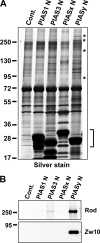Rod/Zw10 complex is required for PIASy-dependent centromeric SUMOylation
- PMID: 20696768
- PMCID: PMC2952260
- DOI: 10.1074/jbc.M110.153817
Rod/Zw10 complex is required for PIASy-dependent centromeric SUMOylation
Abstract
SUMO conjugation of cellular proteins is essential for proper progression of mitosis. PIASy, a SUMO E3 ligase, is required for mitotic SUMOylation of chromosomal proteins, yet the regulatory mechanism behind the PIASy-dependent SUMOylation during mitosis has not been determined. Using a series of truncated PIASy proteins, we have found that the N terminus of PIASy is not required for SUMO modification in vitro but is essential for mitotic SUMOylation in Xenopus egg extracts. We demonstrate that swapping the N terminus of PIASy protein with the corresponding region of other PIAS family members abolishes chromosomal binding and mitotic SUMOylation. We further show that the N-terminal domain of PIASy is sufficient for centromeric localization. We identified that the N-terminal domain of PIASy interacts with the Rod/Zw10 complex, and immunofluorescence further reveals that PIASy colocalizes with Rod/Zw10 in the centromeric region. We show that the Rod/Zw10 complex interacts with the first 47 residues of PIASy which were particularly important for mitotic SUMOylation. Finally, we show that depletion of Rod compromises the centromeric localization of PIASy and SUMO2/3 in mitosis. Together, we demonstrate a fundamental mechanism of PIASy to localize in the centromeric region of chromosome to execute centromeric SUMOylation during mitosis.
Figures







Similar articles
-
Identification of a new small ubiquitin-like modifier (SUMO)-interacting motif in the E3 ligase PIASy.J Biol Chem. 2017 Jun 16;292(24):10230-10238. doi: 10.1074/jbc.M117.789982. Epub 2017 Apr 28. J Biol Chem. 2017. PMID: 28455449 Free PMC article.
-
PIASy mediates SUMO-2/3 conjugation of poly(ADP-ribose) polymerase 1 (PARP1) on mitotic chromosomes.J Biol Chem. 2010 May 7;285(19):14415-23. doi: 10.1074/jbc.M109.074583. Epub 2010 Mar 12. J Biol Chem. 2010. PMID: 20228053 Free PMC article.
-
SUMOylation regulates polo-like kinase 1-interacting checkpoint helicase (PICH) during mitosis.J Biol Chem. 2015 Feb 6;290(6):3269-76. doi: 10.1074/jbc.C114.601906. Epub 2015 Jan 6. J Biol Chem. 2015. PMID: 25564610 Free PMC article.
-
SUMOylation in control of accurate chromosome segregation during mitosis.Curr Protein Pept Sci. 2012 Aug;13(5):467-81. doi: 10.2174/138920312802430563. Curr Protein Pept Sci. 2012. PMID: 22812528 Free PMC article. Review.
-
Interplay of the SUMO and MAP kinase pathways.Ernst Schering Res Found Workshop. 2006;(57):193-209. doi: 10.1007/3-540-37633-x_11. Ernst Schering Res Found Workshop. 2006. PMID: 16568956 Review.
Cited by
-
SUMOylation of the C-terminal domain of DNA topoisomerase IIα regulates the centromeric localization of Claspin.Cell Cycle. 2015;14(17):2777-84. doi: 10.1080/15384101.2015.1066537. Epub 2015 Jul 1. Cell Cycle. 2015. PMID: 26131587 Free PMC article.
-
dsRNAi-mediated silencing of PIAS2beta specifically kills anaplastic carcinomas by mitotic catastrophe.Nat Commun. 2024 May 14;15(1):3736. doi: 10.1038/s41467-024-47751-1. Nat Commun. 2024. PMID: 38744818 Free PMC article.
-
Moonlighting functions of the NRZ (mammalian Dsl1) complex.Front Cell Dev Biol. 2014 Jun 11;2:25. doi: 10.3389/fcell.2014.00025. eCollection 2014. Front Cell Dev Biol. 2014. PMID: 25364732 Free PMC article. Review.
-
Novel Role for Protein Inhibitor of Activated STAT 4 (PIAS4) in the Restriction of Herpes Simplex Virus 1 by the Cellular Intrinsic Antiviral Immune Response.J Virol. 2016 Apr 14;90(9):4807-4826. doi: 10.1128/JVI.03055-15. Print 2016 May. J Virol. 2016. PMID: 26937035 Free PMC article.
-
Deficient sumoylation of yeast 2-micron plasmid proteins Rep1 and Rep2 associated with their loss from the plasmid-partitioning locus and impaired plasmid inheritance.PLoS One. 2013;8(3):e60384. doi: 10.1371/journal.pone.0060384. Epub 2013 Mar 28. PLoS One. 2013. PMID: 23555963 Free PMC article.
References
Publication types
MeSH terms
Substances
Grants and funding
LinkOut - more resources
Full Text Sources

